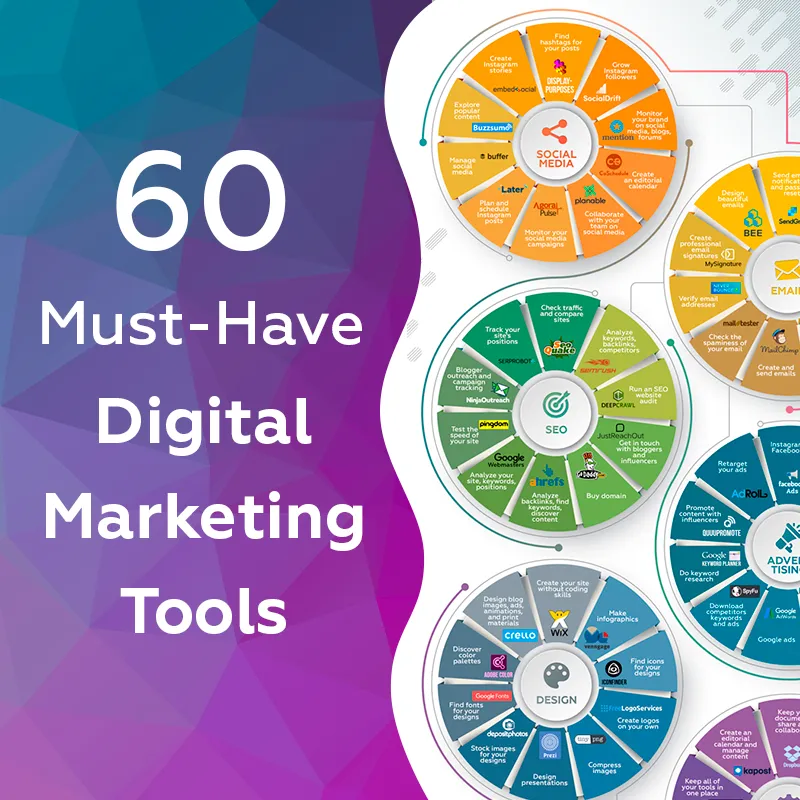Glossary of 50+ Must-Know Digital Marketing Terms
Digital marketing is a unique realm that lives by its laws and has its special language. To be like a fish in water, you must have a good command of professional vocabulary. Understanding industry jargon becomes a pointer to strategic decision-making. Whether you’re a seasoned marketer or a newcomer, these 50+ must-know digital marketing terms will empower you to communicate effectively and stay ahead in 2024 and beyond.
To help you refresh your knowledge or fill in the gaps, we’ve created a comprehensive list of key definitions, from general marketing terms to social media marketing terms and email marketing terms. Bookmark it, revisit it, and let it guide your successful online strategies.
A–B: foundations of digital marketing
A/B testing
Our glossary of digital marketing terms starts with A/B testing. This methodology revolutionizes decision-making by comparing two variants of a single variable. Imagine tweaking your email subject line or landing page design to see which version resonates more with your audience. This data-driven approach removes guesswork, allowing marketers to fine-tune campaigns for maximum impact.
Affiliate marketing
What is affiliate marketing in simple terms? It’s a marketing model that creates a collaborative environment where partnerships fuel growth. Picture a blogger recommending your product and earning a commission for each sale. This symbiotic relationship extends your reach while providing value to content creators and consumers alike. In 2024, affiliate marketing spending in the U.S. reached $8.2 billion, highlighting its growing importance.
Affiliate marketing terms include referrals and referral programs that allow loyal users to earn money from recommendations. For example, with the Depositphotos referral program, you can receive a 40% cash reward from your friends’ first purchase and 15% from their next ones for 3 years!
Analytics
Analytics serves as the compass that guides your digital journey. By decoding user behavior, traffic sources, and conversion patterns, you gain invaluable insights to steer your marketing ship. It’s like having a crystal ball that reveals what works and what doesn’t in real time. Want to take your analytics to an advanced level? Take advantage of AI technologies such as machine learning, NLP, and predictive analytics to deliver data-driven and cost-effective solutions.
API
API (Application Programming Interface) is one of those digital marketing terms that can be a bit confusing. To use an analogy, it acts as a digital handshake between different software systems. Imagine seamlessly integrating your e-commerce platform with your CRM, creating a unified ecosystem that enhances customer experiences and streamlines operations. The best part is that you can easily see it in action. Wondering how? Discover API suite featuring an intuitive graphic design editor, a 300M+ stock content library, and a powerful set of AI-based tools to elevate your strategy and drive business growth.
B2B and B2C
B2B (Business-to-business) is a model in which one company sells goods or services to another, not the end user. For example, a computer hardware manufacturer can sell its products to other companies that assemble PCs or provide IT services. Meanwhile, B2C (Business-to-consumer) is a model in which a company sells goods or services directly to the end user. While B2B focuses on long-term relationships and complex decision-making processes, B2C thrives on emotional connections and immediate value propositions. Understanding these nuances is key to tailoring your strategies effectively.
Branding
Branding is a real buzzword in the marketing terms lexicon. But it goes beyond just logos and color schemes. It’s the DNA of your business, encompassing your values, voice, and unique selling proposition. A strong brand creates an emotional bond with your audience, fostering loyalty and recognition in a crowded digital landscape. Moreover, smart branding can increase revenue, as 46% of consumers are more likely to pay more when they buy from a trusted brand.
Buyer persona
A buyer persona breathes life into your target audience. By creating a semi-fictional representation of your ideal customer, you gain deep insights into their needs, pain points, and motivations. This empathy-driven approach allows you to craft hyper-relevant content and offers that resonate on a personal level. Curious how this affects business performance? Companies using buyer personas see a 2-5 times increase in marketing effectiveness.
C–D: core concepts and metrics
Call-to-action
In marketing, core concepts and metrics guide strategies to success. The journey begins with a well-known digital marketing term, call-to-action (CTA)—a powerful tool that prompts an immediate response. Like a digital neon sign beckoning users to “Subscribe now” or “Get a free trial,” CTAs transform passive browsers into active participants, boosting conversion rates by up to 161% when strategically placed.
Content marketing
Content marketing reigns supreme, creating and distributing relevant, consistent content to attract and retain a defined audience. It’s akin to planting trust seeds that blossom into customer loyalty. While creating content consumes a lot of time and effort, you can always streamline the process by accessing the Depositphotos library of 299M+ high-quality photos, vectors, videos, and music. And if you need unique images, try our AI generator to create commercially safe visuals in seconds.
CPC and CPM
Let’s move on to the must-know marketing abbreviations. In pay-per-click (PPC) campaigns, cost-per-click (CPC) plays a crucial role. It represents the actual price paid for each click, with savvy marketers balancing CPC against potential return. In terms of marketing, what does CPM stand for? This acronym refers to the cost per mille. Simply put, this is the price advertisers pay for every thousand impressions, which is particularly valuable for brand awareness campaigns.
CTR
Success measurement requires a keen eye on metrics. Click-through rate (CTR) serves as the pulse of user engagement, indicating the percentage of people clicking on a specific link or ad. A healthy CTR signals content relevance and ad effectiveness. Some interesting statistics: a CTR above 3% is considered a good indicator for SEO. Simply put, this means that out of 100 people who come across your website, 3 click on it.
CRO
Conversion rate optimization (CRO) focuses on increasing the percentage of visitors taking desired actions and fine-tuning strategies for peak performance. It’s the process of optimizing a website to get more leads and orders at the same level of traffic. This approach can be compared to SEO. The difference is that CRO is focused on optimizing the website’s interface, functionality, and marketing packaging in the context of user experience, while SEO is targeted at optimizing content for search engines.
Direct marketing
What is marketing in simple terms? It’s the process of turning a consumer into a client. Types of marketing differ in the approaches used to achieve this goal. For example, direct marketing is based on direct communication with the consumer of a product or service without involving third parties. It aims to cut through the noise, delivering personalized messages to potential customers. This one-on-one approach allows for targeted communication and measurable results, with email marketing yielding an average ROI between $36 to $42 for every $1 spent.
Display ads
Display ads serve as internet billboards, combining visual appeal with strategic placement. These eye-catching graphics appear across digital platforms, raising brand awareness and driving traffic. Advanced targeting options enable reaching specific demographics, interests, and behaviors, making display ads a powerful tool in the marketer’s arsenal. A smart choice of colors that immediately catch the eye and set the desired mood helps maximize their effect.
E–F: E-commerce and engagement strategies
E-commerce
E-commerce dominates the digital marketplace and is transforming the way businesses connect with consumers. This virtual storefront revolution has redefined retail, offering 24/7 accessibility and global reach. Savvy entrepreneurs leverage platforms like Shopify and WooCommerce, creating seamless shopping experiences that rival brick-and-mortar establishments. Nowadays, it’s not so difficult to build your own online store to interact directly with online customers and increase profits.
Email marketing
Email marketing, a stalwart of brand communication, is one of the leading digital marketing terms. In this approach, personalization is key, with AI-driven tools crafting tailored messages that resonate with individual recipients. From welcome sequences to abandoned cart reminders, email campaigns nurture leads through the sales funnel with precision. Strong design plays an important role here since the average user receives 121 emails a day, so the competition for attention is very high.
Engagement rate
Engagement rate serves as the pulse of digital interactions, measuring how audiences connect with content across platforms. It’s not just about likes and shares; it’s about fostering meaningful conversations and brand loyalty. Marketers now focus on micro-interactions, those small engagements that build lasting relationships over time. For instance, a well-timed emoji reaction or a personalized comment can significantly boost customer sentiment.
Experiential marketing
Experiential marketing is all about creating unique brand experiences to win customers’ hearts. To do this, brands create memorable events that arouse strong positive associations. These can be striking presentations, pop-up stores, or guerrilla marketing campaigns. Experiential marketing also blurs the digital and physical realms, creating immersive experiences. VR product demos and AR try-ons are no longer sci-fi fantasies but realities. These innovative approaches don’t just sell products; they provide special moments that consumers eagerly share, amplifying brand reach organically.
Four Ps of marketing
The four classic Ps of marketing (or marketing mix), product, price, place, and promotion, have taken their place among the digital marketing terms. Personalization emerges as the fifth P, tailoring offerings to individual preferences. In this data-driven landscape, businesses dynamically adjust pricing strategies and distribution channels based on real-time market insights. For example, dynamic pricing algorithms can optimize product costs based on demand, time of day, or even weather conditions.
Facebook Ads Manager
Facebook Ads Manager stands as a powerhouse for targeted advertising. Its sophisticated algorithms allow marketers to pinpoint audiences with laser precision, from interests to behaviors. Dynamic ads automatically showcase products to users who’ve expressed interest, while lookalike audiences expand reach to similar high-potential consumers. The platform’s integration with Instagram and WhatsApp creates a holistic ecosystem for multi-channel campaigns, enabling businesses to reach users across various touchpoints in their digital journey.
G–H: growth tactics and social media tools
Gated content
Gated content acts as a digital gatekeeper, offering valuable resources in exchange for user information. This clever tactic not only generates leads but also cultivates a sense of exclusivity, enticing users with premium insights. The bottom line is that gated content offers users an obvious practical value. For example, in our articles, you’ll find 100 free image and video collections for your seasonal campaigns, a detailed creative brief template, a list of the best leadership books, and more.
Geotargeting
Geotargeting is a digital marketing term you’ve probably heard a thousand times. It elevates personalization to new heights, delivering tailored content based on a user’s location. Imagine a coffee chain promoting pumpkin spice lattes to users in colder climates, while simultaneously advertising iced beverages to those in warmer regions. This hyper-relevant approach can easily boost engagement rates and increase conversions.
Google Analytics
At the heart of data-driven decision-making lies Google Analytics, an insights storehouse. This tool unveils user behavior, traffic sources, and conversion patterns, enabling marketers to refine strategies with surgical precision. By leveraging its advanced features, like custom dimensions and cross-device tracking, businesses can uncover hidden opportunities and optimize their digital presence for maximum impact.
Guerrilla marketing
Guerrilla marketing thrives on creativity and surprise, leveraging unconventional tactics to capture attention in a saturated digital landscape. Imagine a virtual flash mob in a popular online game or a cleverly disguised branded meme that goes viral. These out-of-the-box approaches can generate buzz at a fraction of the cost of traditional campaigns.
Hashtags
Hashtags refer to the main social media marketing terms. They serve as digital connectors, linking conversations and amplifying reach. Beyond mere categorization, strategic hashtag use can spark movements and foster community engagement. For example, a sustainability-focused brand might create a campaign around #EcoWarrior, encouraging users to share their environmentally friendly actions. This user-generated content not only extends organic reach but also builds brand authenticity and loyalty.

I–L: from influencer marketing to LTV
Influencer marketing
In digital marketing, influencer partnerships have become game-changers. By collaborating with personalities who resonate with their target audience, brands tap into pre-established trust and credibility. Influencer marketing isn’t just about celebrity endorsements; it’s about leveraging authentic voices to amplify brand messages. A recent study revealed that 69% of consumers rely on influencer recommendations, making this strategy a powerful tool for brand growth.
Keywords
Our list of primary digital marketing terms would not be complete without keywords, the foundation of SEO. They act as bridges between user intent and your content. By strategically incorporating relevant keywords, businesses can improve visibility and attract qualified traffic. It’s not about filling content with buzzwords, but crafting meaningful narratives that naturally incorporate terms your audience is searching for. Tools like Google’s Keyword Planner can help identify high-value keywords in your niche.
KPI
To measure success effectively, marketers rely on key performance indicators (KPIs). These quantifiable metrics serve as navigational beacons, guiding strategies and highlighting areas for improvement. Whether it’s conversion rates, customer acquisition costs, or revenue growth, KPIs provide concrete data to inform decision-making and demonstrate ROI. Successful businesses often align their KPIs with broader company objectives to ensure marketing efforts drive overall growth.
Landing
The journey from visitor to customer often begins on a landing page. This digital front door is designed with a singular focus: converting visitors into leads. By eliminating distractions and presenting a clear value proposition, effective landing pages can increase conversion rates by up to 25%. Each lead represents a potential long-term relationship, making lead generation a crucial aspect of sustainable growth. A/B testing different landing page elements can help optimize their performance over time.
LTV
One more common acronym in the list of digital marketing terms is LTV or lifetime value, the North Star for customer-centric businesses. Focusing on LTV encourages brands to nurture lasting relationships rather than chasing short-term gains. By calculating the total revenue a customer is expected to generate over their relationship with a company, marketers can make informed decisions about acquisition costs and retention strategies. This approach often leads to more sustainable growth and higher client satisfaction.

M–O: marketing strategies and automation
Market research
In marketing terms, what is a market? It is any place (physical or digital) where sellers offer goods and services to consumers. The main task of a business is to offer the right product to the right audience at the right place and time. And this is where market research comes in. It serves as the foundation, unearthing valuable insights into consumer behavior and industry trends. By leveraging data-driven methodologies, businesses can make informed decisions that resonate with their target audience and increase customer satisfaction rates.
Marketing automation
Marketing automation streamlines repetitive tasks, nurtures leads, and personalizes customer interactions at scale. Imagine a system automatically sending tailored follow-up emails based on a prospect’s interaction with your website. This is just one example of what AI technologies in marketing can do. Other automation advantages include improving data quality, optimizing campaigns, decreasing costs, and more.
Marketing myopia
Marketing myopia is one of the digital marketing terms you might not have heard of. Simply put, it’s shortsightedness that focuses solely on products rather than customer needs. This tunnel vision can lead to missed opportunities and declining relevance. To avoid it, adopt a customer-centric approach that anticipates future needs and adapts to changing market dynamics.
Mobile marketing
Mobile marketing has become indispensable as smartphones dominate consumer attention. From location-based push notifications to mobile-optimized content, businesses must craft seamless experiences for on-the-go users. With mobile devices accounting for over 58% of global web traffic, neglecting this channel is no longer an option. Companies embracing mobile-first strategies report a 30% increase in conversion rates.
Native advertising
Native advertising blurs the lines between content and promotion, offering a non-disruptive way to engage audiences. By matching the form and function of the platform it appears on, native ads capture attention without feeling intrusive. This subtle approach has shown to increase purchase intent by 18% compared to traditional banner ads and boosts brand recall by 25%.
OKR
OKRs (objectives and key results) provide a framework for setting ambitious goals and measuring progress. This methodology aligns teams, fosters transparency, and drives measurable outcomes. By implementing OKRs, marketing departments can increase goal attainment, ensuring every effort contributes to overarching business objectives. Companies utilizing OKRs consistently outperform competitors in achieving strategic goals.
Organic reach
Organic reach is an essential digital marketing term that refers to SMM and SEO. While challenging in today’s pay-to-play environment, it remains crucial for sustainable growth. By creating compelling, shareable content and fostering genuine community engagement, brands can amplify their message without relying solely on paid promotion. Businesses focusing on organic strategies report reduced customer acquisition costs over time.

P–R: from paid advertising to ROI
Paid advertising
The range of paid advertising encompasses various formats, from social media sponsored posts to display banners on high-traffic websites. Each platform offers unique targeting capabilities, allowing marketers to tailor their message to specific demographics, interests, and behaviors. For instance, a luxury watch brand might leverage Instagram’s visual-centric ads to showcase their timepieces to fashion-conscious millennials.
PPC
Among the most popular digital marketing terms is pay-per-click (PPC), a model where marketers only pay when users click on their ads. This cost-effective approach allows for precise budget control and measurable results. Imagine a local bakery using Google Ads appearing at the top of search results for “fresh pastries near me,” instantly connecting with hungry customers actively seeking their offerings.
Product lifecycle
Understanding the product lifecycle is vital for effective advertising strategies. As products move from introduction to growth, maturity, and decline, marketing tactics must evolve. A tech startup might initially focus on awareness-building ads, then shift to competitive positioning as the market saturates, and finally emphasize customer loyalty in the maturity phase. This adaptive approach can boost customer retention rates.
Retargeting
Retargeting has emerged as a powerful tool in the marketer’s arsenal. By showing ads to users who’ve previously interacted with a brand, businesses can recapture lost opportunities. Picture an online shopper abandoning their cart, only to be gently reminded of their intended purchase through strategically placed ads across their favorite websites. This can increase conversion rates by almost 150%, turning missed opportunities into sales.
ROI
This marketing term is used all the time in professional communication. ROI (return on investment) helps to measure the success of marketing strategies. This critical metric compares the cost of advertising campaigns against the revenue generated. Savvy marketers continuously analyze and optimize their efforts, reallocating resources to high-performing channels. For example, a B2B software company might discover that LinkedIn ads yield a higher ROI for lead generation compared to traditional display advertising, prompting a shift in budget allocation.

S–U: SEO, social media, and user experience
SEO
Search engine optimization (SEO) acts as the invisible force that propels websites to the forefront of search results. By strategically optimizing content, structure, and backend elements, businesses can dramatically increase their online visibility. Imagine SEO as a digital lighthouse, guiding potential customers through the vast internet ocean directly to your virtual doorstep. With 68% of online experiences beginning with a search engine, mastering SEO is vital for digital success.
SMM
Social media marketing (SMM) transforms this visibility into engagement, creating vibrant communities around brands. It’s not just about posting; it’s about crafting narratives that resonate. Think of SMM as a digital cocktail party, where brands mingle with consumers, sharing stories and building relationships that transcend traditional advertising boundaries. Platforms like Instagram and TikTok have revolutionized brand-consumer interactions, with 54% of people using social media to research products.
Social listening
Social listening is the art of tuning into online conversations. Why did we add it to our list of digital marketing terms? By monitoring mentions, sentiment, and trends, brands gain invaluable insights into consumer perceptions and desires. It’s akin to having a superpower that allows you to hear whispers across the digital landscape, enabling proactive engagement and crisis management. Companies leveraging social listening report a 25% increase in customer satisfaction.
Target audience
Identifying your target audience is a must in this digital dance. It’s about understanding not just demographics but psychographics—the dreams, fears, and motivations that drive consumer behavior. Precision in audience targeting can transform marketing from a scattergun approach to a laser-focused strategy, dramatically improving ROI and customer satisfaction.
Traffic source
Traffic sources act as the roads leading to your digital storefront. From organic search to social media referrals, each source offers unique opportunities and challenges. Analyzing these pathways is like studying the tributaries of a river, allowing you to optimize the flow of visitors and tailor your approach for each channel.
User experience
User Experience (UX) is one of the most common digital marketing terms. It refers to creating digital environments that are not just functional, but delightful. A well-crafted UX is like a perfectly choreographed dance, guiding users effortlessly through your digital space, enhancing satisfaction, and boosting conversions. Studies show that a positive user experience can increase conversion rates by up to 400%.

V–Y: from value proposition to video marketing
Value proposition
A compelling value proposition is the cornerstone of brand differentiation. It’s the unique promise that sets a company apart, answering the crucial question: “Why should customers choose you?” For instance, a sustainable fashion brand might emphasize eco-friendly materials and ethical production processes, appealing to environmentally conscious consumers. This distinct offering is a go-to way to increase customer loyalty and boost conversion rates.
Visual identity
It is one of the digital marketing terms we often refer to in our articles. A strong visual identity creates instant brand recognition across various platforms. It’s more than just a logo; it encompasses color schemes, typography, and imagery that evoke specific emotions and associations. Consider how Apple’s minimalist aesthetic conveys innovation and sophistication, contributing to its premium positioning.
Word-of-mouth marketing
Word-of-mouth marketing harnesses the power of personal recommendations in the digital age. It goes beyond satisfied customers telling friends; it’s about creating shareable experiences that ignite online conversations. For example, a restaurant might design an Instagram-worthy dish that diners eagerly share, sparking curiosity and attracting new patrons. This organic buzz can be very impactful, since WOM marketing influences about 20-50% of all purchase decisions.
YouTube advertising
YouTube advertising completes our glossary of digital marketing terms. This platform has revolutionized video marketing strategies, offering unparalleled reach and targeting capabilities. With over 2 billion logged-in monthly users, it’s a goldmine for brands seeking to engage audiences through visual storytelling. Innovative formats like skippable in-stream ads and bumper ads allow for creative flexibility and precise audience targeting. As a result, 88% of marketers report a positive ROI on YouTube ads.
To sum up
As we conclude our journey through the marketing lexicon, it’s clear that mastering digital marketing terms is more than expanding vocabulary—it’s about empowering your strategy with precision and insight. Consider this glossary your roadmap to business goals. As you implement these strategies, you’ll find yourself speaking the language of digital success fluently, navigating complexities with confidence. Embrace this knowledge, and watch your campaigns soar to new heights.
Other articles about marketing
40 Types of Marketing: Exploring Diverse Strategies for Business Success
The 4 Ps of Marketing Explained: Simple Guide for Everyone














